CCC Notes in English
Hello students in this article you can find your query related to CCC Notes in English, Computer memory units, Input and output devices, Hardware and Software definition, Computer Language and its types
Computer memory chart, Input devices of computer, hardware and software difference, computer language definition, कंप्यूटर मेमोरी के प्रकार
CCC Notes in English
 |
| CCC Notes in English |
MEMORY SYSTEM IN A COMPUTER
There
are two kinds of computer memory: primary and secondary. Primary
memory is accessible directly by the processing unit. RAM is an example of
primary memory You can store and retrieve data much faster with primary memory
compared to secondary memory. Secondary memory such as Floppy disks, Magnetic
disk, CD, etc., is located outside the computer.
1. Random Access Memory (RAM): The primary storage is referred to as random
access memory (RAM) because it is possible to randomly select and use any
location of the memory directly store and retrieve data. Each of RAM’s
locations stores one byte of information. As soon as the computer is
switched off the contents of the primary memory is lost. So now we can say that
RAM is volatile memory.
 |
| Computer Memory |
Fig. : RAM
2. Read Only Memory (ROM): There is another memory in computer, which is called Read Only Memory
(ROM). Again it is the ICs inside the PC that form the ROM. The storage of
program and data in the ROM is permanent. The ROM stores some standard
processing programs supplied by the manufacturers to operate the personal
computer. The ROM can only be read by the CPU but it cannot be changed.
The basic input/output (BIOS) program is stored in the ROM that examines and initializes
various equipment attached to the PC when the switch is made ON. The memories,
which do not loose their content on failure of power supply, are known as non-volatile
memories. ROM is non-volatile memory.
3. PROM There
is another type of primary memory in computer, which is called Programmable
Read Only Memory (PROM).
4. EPROM: This
stands for Erasable Programmable Read Only Memory, which over come the problem
of PROM & ROM.
5. Cache Memory: The speed of CPU is extremely high compared to the access time of main
memory. Therefore the performance of CPU decreases due to the slow speed of
main memory. To decrease the mismatch in operating speed, a small memory chip
is attached between CPU and Main memory whose access time is very close to the
processing speed of CPU. It is called CACHE memory.
SECONDARY
STORAGE
1. Hard Disk Drive:
The hard drive
is the data center of the computer. This is where the software is
installed, and it's also where your documents and other files are stored. The
hard drive is long-term storage, which means the data is still saved
even if you turn the computer off or unplug it.
When you run a program
or open a file, the computer copies some of the data from the hard drive onto
the RAM so that it can access the data more easily. When you save a
file, the data is copied back to the hard drive. The faster the hard
drive is, the faster your computer can start up and load programs.
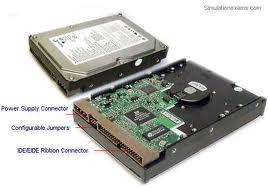 |
| Hard Disk Drive |
Fig. : Hard Disk Drive
2.
Magnetic Tape: Magnetic tapes are used for large computers like
mainframe computers where large volume of data is stored for a longer time. In
PC also you can use tapes in the form of cassettes.
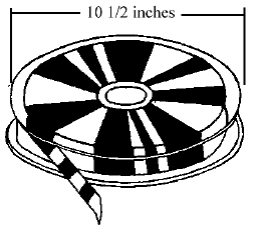 |
| Magnetic Tape |
Fig. : Magnetic Tape
3.
Floppy Disk: It is similar to magnetic disk. They are 5.25 inch or 3.5
inch in diameter. The capacity of a 5.25-inch floppy is 1.2 mega bytes whereas
for 3.5 inch floppy it is 1.44 mega bytes.
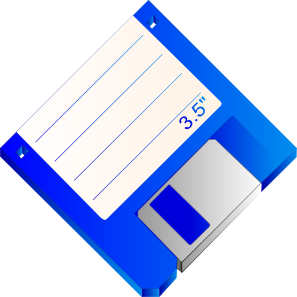 |
| Floppy Disk |
Fig. : Floppy Disk
4. Optical Disk: Compact Disk/ Read Only Memory (CD-ROM): CD-ROM disks are made of reflective metals. CD-ROM is written during the process of manufacturing by high power laser beam. Here the storage density is very high, storage cost is very low and access time is relatively fast.
Each disk is
approximately 4 1/2 inches in diameter and can hold over 600 MB of data. As the
CD-ROM can be read only we cannot write or make changes into the data
contained in it.
Unit of Computer Memory:
Bit is
the smallest unit of data storage in computers
1 Bit = 1 Character
1 Nibble = 4
Bits
1 Byte = 8
Bits
1 Kilo Byte = 1024
Byte
1 Mega Byte = 1024
Kilo Byte (KB)
1 Giga Byte = 1024
Mega Byte (MB)
INPUT DEVICES
1. Keyboard: - This is the
standard input device attached to all computers. The layout of keyboard is just
like the traditional typewriter.
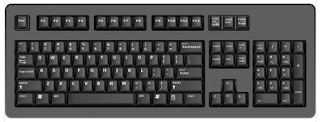 |
| Keyboard |
Fig. : Key Board
2.
Mouse: - Mouse is an input device shown in Fig. 2.8 that is used with
your personal computer. It rolls on a small ball and has two or three buttons
on the top. When you roll the mouse across a flat surface the screen censors
the mouse in the direction of mouse movement.
 |
| Mouse |
Fig. : Mouse
3.
Scanner: If we want to input a picture the keyboard cannot do that.
Scanner is an optical device that can input any graphical matter and display it
back. The common optical scanner devices are Magnetic Ink Character Recognition
(MICR), Optical Mark Reader (OMR) and Optical Character Reader (OCR).
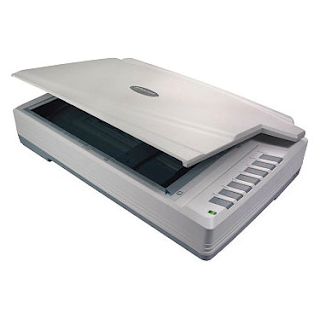 |
| Scanner |
Fig. : Scanner
Magnetic
Ink Character Recognition (MICR): - This is widely used by banks to process large volumes of cheques and
drafts. Cheques are put inside the MICR. As they enter the reading unit the
cheques pass through the magnetic field which causes the read head to recognise
the character of the cheques.
Optical
Mark Reader (OMR): This
technique is used when students have appeared in objective type tests and they
had to mark their answer by darkening a square or circular space by pencil.
These answer sheets are directly fed to a computer for grading where OMR is
used.
Optical
Character Recognition (OCR): - This technique unites the direct reading of any printed character.
Suppose you have a set of hand written characters on a piece of paper. You put
it inside the scanner of the computer. This pattern is compared with a site of
patterns stored inside the computer. Whichever pattern is matched is called a
character read. Patterns that cannot be identified are rejected. OCRs are
expensive though better the MICR.
OUTPUT DEVICES
1. Visual Display Unit: The most popular input/output
device is the Visual Display Unit (VDU). It is also called the monitor.
2. Terminals: It is a very popular interactive
input-output unit. It can be divided into two types: hard copy terminals and soft
copy terminals. A hard copy terminal provides a printout on paper
whereas soft copy terminals provide visual copy on monitor.
3. Printer:
It is an important output device which can be used to get a printed copy of
the processed text or result on paper.
Types of Printer: There are different types of printers that are designed for different
types of applications. Depending on their speed and approach of printing,
printers are classified as impact and non-impact printers.
1. Impact Printer: Impact printers use the familiar typewriter approach of hammering a
typeface against the paper and inked ribbon. Dot-matrix printers are of
this type.
2. Non- Impact Printer: Non-impact
printers do not hit or impact a ribbon to print. They use electro-static
chemicals and ink-jet technologies. Laser printers and Ink-jet
printers are of this type.
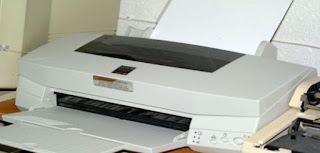 |
| Printer |
HARDWARE/SOFTWARE
WHAT IS HARDWARE?
Hardware
are those parts of computer to which we can see, fell as well as touch. These
parts of computer are called hardware. For example Monitor, Keyboard, mouse,
CD/DVD etc.
 |
| Computer Hardware |
Fig. : HARDWARE
WHAT IS SOFTWARE?
As you know computer cannot do
anything without instructions from the user. In order to do any specific job
you have to give a sequence of instructions to the computer. This set of
instructions is called a computer program. Software refers to the set of
computer programs.
 |
| Computer Software |
Fig.
: Software
TYPES OF SOFTWARE
- Application Software
- System software
Example: Microsoft Word, Spreadsheet,
MS-Paint, Notepad, WordPad.
2. System Software: When you switch on the computer
the programs written in ROM is executed which activates different units of your
computer and makes it ready for you to work on it. This set of program can be
called system software. System software are general programs designed for
performing tasks such as controlling all operations required to move data into
and out of the computer.
Remember that it is not possible
to run application software without system software.
Example: DOS, Windows, LINUX, UNIX,
Antivirus.
WHAT IS COMPUTER LANGUAGE?
You are aware with the term language. It is a system of communication between you and me. Some of the basic natural languages that we are familiar with are English, Hindi, and German etc. But how you will communicate with your computer.
Your computer will not understand any of these natural languages for
transfer of data and instruction. Computer understand only Binary Language that
is ‘0’ and ‘1’ and perform all tasks in that language, it is also called
Machine language.
Programming Languages
There
are two major types of programming languages. These are Low Level Languages and
High Level Languages. Low Level languages are further divided in to Machine
language and Assembly language.
1.
Low Level Languages
Low
level languages are machine oriented and require extensive knowledge of
computer hardware and its configuration.
(a)
Machine Language
Machine
Language is the only language that is directly understood by the computer. It
does not needs any translator program. We also call it machine code and it is
written as strings of 1's (one) and 0’s (zero).
(b)
Assembly Language
It
is the first step to improve the programming structure. You should know that
computer can handle numbers and letter. Therefore some combination of letters
can be used to substitute for number of machine codes.
The
set of symbols and letters forms the Assembly Language and a translator program
is required to translate the Assembly Language to machine language. This
translator program is called `Assembler'. It is considered to be a
second-generation language.
2.
HIGH LEVEL LANGUAGES
Higher
level languages are problem-oriented languages because the instructions are
suitable for solving a particular problem. For example COBOL (Common Business
Oriented Language) is mostly suitable for business oriented language where
there is very little processing and huge output. There are mathematical
oriented languages like FORTRAN (Formula Translation) and BASIC (Beginners
All-purpose Symbolic Instruction Code) where very large processing is required.
Language Translator
1.
Compiler
It
is a program translator that translates the instruction of a higher level language
to machine language. It is called compiler because it compiles machine language
instructions for every program instructions of higher level language. Thus
compiler is a program translator like assembler but more sophisticated. It
scans the entire program first and then translates it into machine code.
Higher
Level Language --> (Compile) ---> Program --> Machine Language Program
2.
Interpreter
An
interpreter is another type of program translator used for translating higher
level language into machine language. It takes one statement of higher level
languages, translate it into machine language and immediately execute it.












Please do not enter any spam link in the comment box